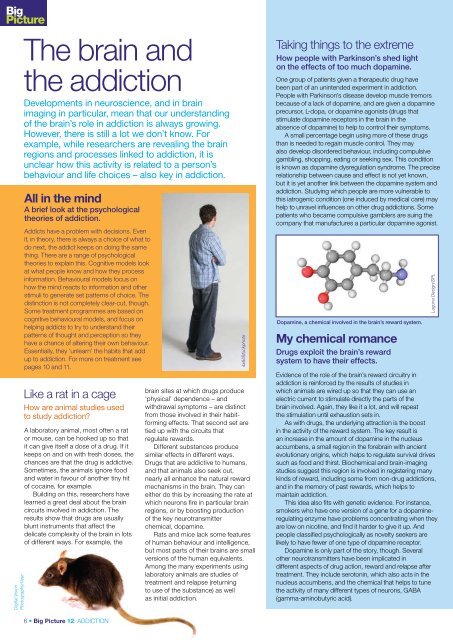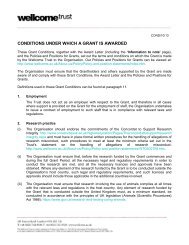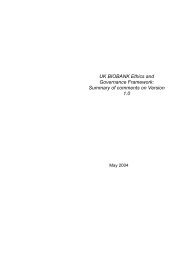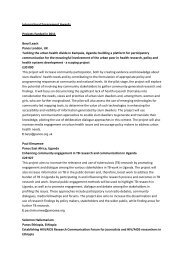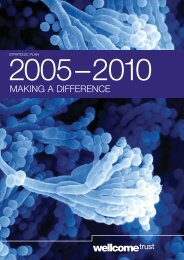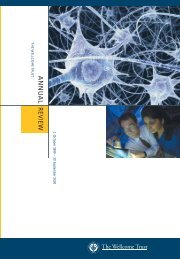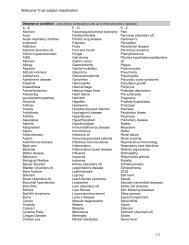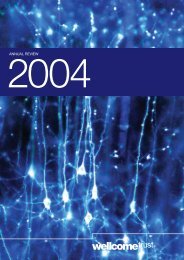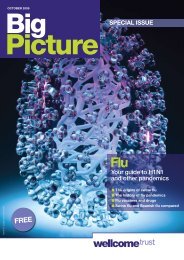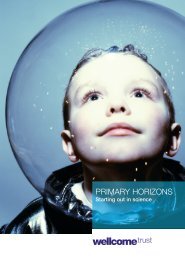Big Picture: Addiction - Wellcome Trust
Big Picture: Addiction - Wellcome Trust
Big Picture: Addiction - Wellcome Trust
Create successful ePaper yourself
Turn your PDF publications into a flip-book with our unique Google optimized e-Paper software.
<strong>Big</strong><br />
<strong>Picture</strong><br />
Digital Vision<br />
Photography/Veer<br />
The brain and<br />
the addiction<br />
Developments in neuroscience, and in brain<br />
imaging in particular, mean that our understanding<br />
of the brain’s role in addiction is always growing.<br />
However, there is still a lot we don’t know. For<br />
example, while researchers are revealing the brain<br />
regions and processes linked to addiction, it is<br />
unclear how this activity is related to a person’s<br />
behaviour and life choices – also key in addiction.<br />
All in the mind<br />
A brief look at the psychological<br />
theories of addiction.<br />
Addicts have a problem with decisions. Even<br />
if, in theory, there is always a choice of what to<br />
do next, the addict keeps on doing the same<br />
thing. There are a range of psychological<br />
theories to explain this. Cognitive models look<br />
at what people know and how they process<br />
information. Behavioural models focus on<br />
how the mind reacts to information and other<br />
stimuli to generate set patterns of choice. The<br />
distinction is not completely clear-cut, though.<br />
Some treatment programmes are based on<br />
cognitive behavioural models, and focus on<br />
helping addicts to try to understand their<br />
patterns of thought and perception so they<br />
have a chance of altering their own behaviour.<br />
Essentially, they ‘unlearn’ the habits that add<br />
up to addiction. For more on treatment see<br />
pages 10 and 11.<br />
Like a rat in a cage<br />
How are animal studies used<br />
to study addiction<br />
A laboratory animal, most often a rat<br />
or mouse, can be hooked up so that<br />
it can give itself a dose of a drug. If it<br />
keeps on and on with fresh doses, the<br />
chances are that the drug is addictive.<br />
Sometimes, the animals ignore food<br />
and water in favour of another tiny hit<br />
of cocaine, for example.<br />
Building on this, researchers have<br />
learned a great deal about the brain<br />
circuits involved in addiction. The<br />
results show that drugs are usually<br />
blunt instruments that affect the<br />
delicate complexity of the brain in lots<br />
of different ways. For example, the<br />
4x6/iStockphoto<br />
brain sites at which drugs produce<br />
‘physical’ dependence – and<br />
withdrawal symptoms – are distinct<br />
from those involved in their habitforming<br />
effects. That second set are<br />
tied up with the circuits that<br />
regulate rewards.<br />
Different substances produce<br />
similar effects in different ways.<br />
Drugs that are addictive to humans,<br />
and that animals also seek out,<br />
nearly all enhance the natural reward<br />
mechanisms in the brain. They can<br />
either do this by increasing the rate at<br />
which neurons fire in particular brain<br />
regions, or by boosting production<br />
of the key neurotransmitter<br />
chemical, dopamine.<br />
Rats and mice lack some features<br />
of human behaviour and intelligence,<br />
but most parts of their brains are small<br />
versions of the human equivalents.<br />
Among the many experiments using<br />
laboratory animals are studies of<br />
treatment and relapse (returning<br />
to use of the substance) as well<br />
as initial addiction.<br />
Taking things to the extreme<br />
How people with Parkinson’s shed light<br />
on the effects of too much dopamine.<br />
One group of patients given a therapeutic drug have<br />
been part of an unintended experiment in addiction.<br />
People with Parkinson’s disease develop muscle tremors<br />
because of a lack of dopamine, and are given a dopamine<br />
precursor, L-dopa, or dopamine agonists (drugs that<br />
stimulate dopamine receptors in the brain in the<br />
absence of dopamine) to help to control their symptoms.<br />
A small percentage begin using more of these drugs<br />
than is needed to regain muscle control. They may<br />
also develop disordered behaviour, including compulsive<br />
gambling, shopping, eating or seeking sex. This condition<br />
is known as dopamine dysregulation syndrome. The precise<br />
relationship between cause and effect is not yet known,<br />
but it is yet another link between the dopamine system and<br />
addiction. Studying which people are more vulnerable to<br />
this iatrogenic condition (one induced by medical care) may<br />
help to unravel influences on other drug addictions. Some<br />
patients who became compulsive gamblers are suing the<br />
company that manufactures a particular dopamine agonist.<br />
Dopamine, a chemical involved in the brain’s reward system.<br />
My chemical romance<br />
Drugs exploit the brain’s reward<br />
system to have their effects.<br />
Evidence of the role of the brain’s reward circuitry in<br />
addiction is reinforced by the results of studies in<br />
which animals are wired up so that they can use an<br />
electric current to stimulate directly the parts of the<br />
brain involved. Again, they like it a lot, and will repeat<br />
the stimulation until exhaustion sets in.<br />
As with drugs, the underlying attraction is the boost<br />
in the activity of the reward system. The key result is<br />
an increase in the amount of dopamine in the nucleus<br />
accumbens, a small region in the forebrain with ancient<br />
evolutionary origins, which helps to regulate survival drives<br />
such as food and thirst. Biochemical and brain-imaging<br />
studies suggest this region is involved in registering many<br />
kinds of reward, including some from non-drug addictions,<br />
and in the memory of past rewards, which helps to<br />
maintain addiction.<br />
This idea also fits with genetic evidence. For instance,<br />
smokers who have one version of a gene for a dopamineregulating<br />
enzyme have problems concentrating when they<br />
are low on nicotine, and find it harder to give it up. And<br />
people classified psychologically as novelty seekers are<br />
likely to have fewer of one type of dopamine receptor.<br />
Dopamine is only part of the story, though. Several<br />
other neurotransmitters have been implicated in<br />
different aspects of drug action, reward and relapse after<br />
treatment. They include serotonin, which also acts in the<br />
nucleus accumbens, and the chemical that helps to tune<br />
the activity of many different types of neurons, GABA<br />
(gamma-aminobutyric acid).<br />
Laguna Design/SPL<br />
6 • <strong>Big</strong> <strong>Picture</strong> 12: ADDICTION


